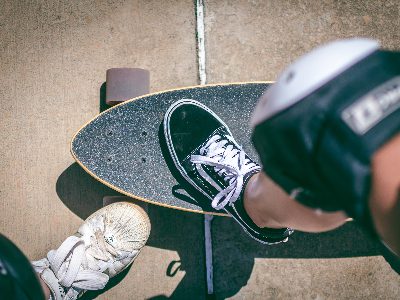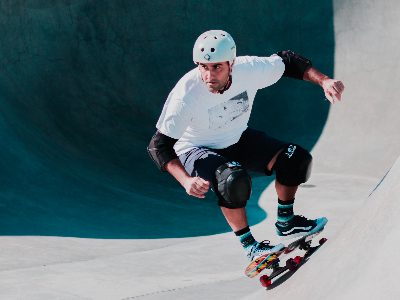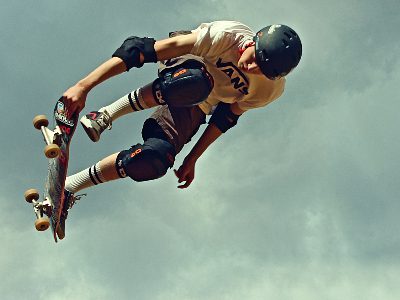We all know that thrill of riding a skateboard, feeling the wind in your hair as you zip down the street at high speeds. But we’re also aware of the risks involved. A sudden fall can lead to severe injuries if you’re not adequately protected. That’s why here at FamilyHype, we believe in the importance of wearing protective gear while skateboarding, including extra gear padding for multiple impacts.

Both beginners and seasoned riders alike must ensure safety while enjoying this exhilarating action sport.
In this article, we’ll guide you through creating your do-it-yourself safety equipment – from helmets to knee pads and wrist guards. We understand that buying these can be pricey and sometimes, they may not fit perfectly or meet your personal style preferences. By making your equipment, you’re assured of comfort and perfect fit, and it’s cost-effective too!
So let’s do our bit for safety while keeping the fun intact as we dive into how to make your own safety equipment right at home!
Key Takeaways
- DIY safety equipment can be a cost-effective and customizable option to ensure comfort and safety while riding your board.
- Crafting a DIY helmet requires materials like foam, padding, and straps, and impact testing is essential for defense.
- DIY knee and elbow pads can be customized for fit and style, offering optimal defense when riding your board.
- Making DIY wrist guards using recycled materials like old jeans or cushions, duct tape, and scissors can ensure wrist protection.
- Regularly maintain and improve your Do-It-Yourself safety equipment by checking for board wear and tear, adding defense layers, customizing for comfort, and cleaning gently.
- It should be enjoyed responsibly, and following safety measures will help prevent injuries and ensure a fun experience.
- Safety equipment should include helmets, pads, and guards, with a focus on shielding the wrists and other vulnerable body parts.
Understanding The Importance Of Safety In Skateboarding
Longboard riding can be an exhilarating experience, but safety is of paramount importance. According to injury statistics, it’s crucial to adhere to safety laws and rules when engaging in action sports like skating.
Here at FamilyHype, we understand the importance of keeping your family safe, especially during high-speed activities like skating, and so we’ve created this guide to give an overview of essential equipment. On top of our list, you’ll find recommendations tailored for maximum safety.
When doing this sport, always remember to put on the right safety equipment. This means wearing a helmet to secure your head, pads for your knees, elbows, and slide defense, and wrist guards to safeguard your arms during falls. Additionally, ensure your longboard is in good condition, that you know the longboard laws in your area, and that you practice safe techniques. Always look out for any sign indicating restricted longboard riding zones or guidelines to follow.
Overview: Essential Skateboard Safety Equipment
Ready to hit the pavement with your longboard? Let’s discuss the essential safety equipment you’ll need to ensure a thrilling yet secure experience. Your customization and comfort considerations should include a reliable helmet with extra padding commonly for head defense, knee, and elbow pads for preventing multiple impacts, and a butt pad for added tailbone safety and shielding your knees and arms during falls. Wearing safety wrist guards will keep your slide in check and secure your hand and palm, and durable shoes are a must for stability while skating. This basic equipment is the foundation of any skater’s safety kit.
Wearing the right safety equipment, like most pads, a helmet that shields your head, and other equipment, is the first step to great safety, preventing injuries if you fall or land wrong on concrete or the ground; ensure the helmet has a removable liner and that pads are worn on the elbows, knees, and palms to stand against potential harm to these areas, including the neck.
By understanding these essentials, we can give better service and encourage safety in doing this sport. It might be a good idea to check out the best buy options for each piece of equipment to ensure quality.
For a do-it-yourself longboard helmet, you’ll need a helmet, padding, foam, and straps to ensure high-speed impact defense. With the right safety equipment, you’ll be ready to hit the pavement and have a safe and fun experience.
Do-It-Yourself Skateboard Helmet
Crafting your longboard helmet can be a rewarding and cost-effective endeavor, allowing you to customize the fit and style according to your personal preferences. With some creativity and diligence, we can create a unique helmet customization that meets our needs. Of course, it’s vital to perform impact testing to ensure safety during action sports.

At FamilyHype, we believe that it’s important to have a safe and secure environment for families, and longboard riding is no exception. That’s why we highly recommend that you take the extra step of creating your own do-it-yourself knee and elbow pads for additional shielding. With the right materials and a bit of patience, you can create a set of pads that are tailored to your individual needs.
If you’re looking to customize your longboard equipment, do-it-yourself longboard helmets are a great way to get started. With the right supplies and a bit of guidance from FamilyHype, you can create a helmet that is comfortable, stylish, and safe. Additionally, making your own knee and elbow pads can be a fun and rewarding experience. Just remember to perform impact testing to ensure that the helmet and pads are up to safety standards.
By taking the time to create your do-it-yourself longboard helmet and pads, you can ensure that your equipment is safe and fits comfortably. Plus, you can feel good knowing that you’ve created something truly unique. So get out there, get creative, and have fun!
Do-It-Yourself Knee And Elbow Pads
Venturing into the world of making your own knee and elbow pads can be an exciting endeavor for enthusiasts. It offers you the chance to customize fit, style, and defense according to your liking for extra padding and slide defense. Navigating material selection is key to ensuring optimal safety for skaters.
Pad customization isn’t just about aesthetics, but safety too. When it comes to longboard riding, it’s important to have the right equipment—especially when it comes to wrist guards to secure your arms. With the right materials, you can create your custom wrist guards, giving you the defense you need while on the board.
Here at FamilyHype, we strive to give helpful advice and tips for riders of all levels. So let us help you secure your wrists as you hit the streets.
Do-It-Your Own Wrist Guards
Ready to take on your next do-it-yourself project? We’re going to show you how to make your wrist guards, a crucial piece of safety equipment for any skater during roller skating.
From gathering the necessary materials to providing you with a step-by-step guide, we’ve got everything covered so that you can focus on staying safe and enjoying the ride. Skate smart, secure yourself, and keep the adrenaline flowing!
Safety Equipment Needed
Safety is the main difference between an exhilarating experience and a potential accident waiting to happen. At FamilyHype, we value the family unit and the safety of all our readers, especially when engaging in adventurous activities like this sport. That’s why it’s so crucial to have the right safety equipment.

Let’s gather up some essential materials, including legs-saving equipment, for our do-it-yourself safety equipment project. We’ll need recycled materials such as old jeans or cushions to give adequate shielding for the legs, duct tape to reinforce the equipment, scissors to cut the materials to size, and a marker to trace out the necessary patterns. Budget planning is key here; by reusing what we have at home, we can save money and still make reliable safety equipment for this sport.
Aside from that, for safe riding, you need wrist pads, abrasion defense like skate shoes, available at a skate shop, with a hard shell giving, especially in colder weather, and flexible equipment to absorb impact energy.
With these materials in hand, we can dive into crafting our safety accessories, taking into account the main difference they can make in case of a fall. We’ll need to consider the safety capabilities of the materials, like the cushion’s ability to absorb impact and secure the legs, as well as the jeans’ durability to withstand abrasions and scrapes. Additionally, we should factor in the comfort of the equipment, ensuring that it doesn’t hinder the skater’s movements, and the visibility of the skater to ensure others can see them clearly, especially during low-light conditions.
It can be a thrilling and enjoyable activity, but taking precautions and having the right equipment can make all the difference, keeping us safe while we have fun on our boards. Remember, shielding our legs and the rest of our bodies is of the utmost importance, so let’s get creative and craft some excellent safety equipment for a worry-free experience!
Step-By-Step Guide
Armed with your recycled materials and creative spirit, let’s dive into the process of crafting your safety accessories for boards. The goal here is equipment customization for optimal injury prevention.
Here at FamilyHype, we value the family unit and want to ensure everyone is safe while having fun. We’ll guide you through each detail, ensuring every piece fits just right and offers maximum defense.
Skateboards require durable defense, from helmets and pads to gloves and shoes, and we’ll give you with the necessary information to customize your safety equipment. Remember, this isn’t just about style; it’s about safeguarding your active lifestyle.
We hope our insights help you create longboard safety accessories that are comfortable and durable, enabling you to enjoy your experience to the fullest.
Next, we’ll share crucial insights on maintaining and improving your do-it-yourself safety equipment over time.
Top Maintenance Tips
At FamilyHype, we understand that this kind of sport is a way to express yourself and share your passion with others. That’s why we’re here to help you stay safe while you do it! Maintaining your do-it-yourself safety equipment is like nurturing a tree – with proper care and attention, it’ll grow stronger over time, providing you with increased safety during your adrenaline-pumping sessions.

Here are four tips for maintaining and improving your longboard safety equipment:
- Regularly check for wear and tear, replacing parts when necessary.
- Add more safety layers, such as elbow and knee pads, as needed.
- Keep up with gear customization, such as adding skateboard foam padding for extra comfort and stability.
- Clean gently with a mild soap and water solution to preserve the skateboard’s integrity.
Remember, safety comes first when it comes to doing this sport! We hope these tips help you maintain and improve your do-it-yourself safety equipment, so you can enjoy your adrenaline-filled sessions with peace of mind.
Conclusion
We’ve walked you through the key safety equipment and how to do it yourself. Here at FamilyHype, we believe that regular maintenance of your safety equipment and longboard is the key to a safe and enjoyable ride. So let’s prioritize our safety, fasten our helmets, padded shorts, pads, and guards – and get out there and enjoy the thrill of longboard riding! Wearing safety equipment is a cornerstone of this sport.
The tips and ideas discussed in this article help keep riders safe, but it’s also important to remember that longboard riding is a sport that should be enjoyed responsibly. We want to encourage you to stay safe and have a good time. After all, that’s what FamilyHype is all about – having a good time with the family unit while staying safe with the right basic equipment setup!
We hope you found this article useful and we’d love to hear your feedback. If you have any questions or comments, please let us know! Longboard riding is an exciting sport and the right safety equipment can help make it even more enjoyable. So go ahead, strap on that helmet, fasten those pads and guards – and ride on!
Frequently Asked Questions (FAQs):
How Can Safety Equipment Secure You When Longboarding?
The safety in doing this sport is crucial. To secure yourself, use appropriate safety equipment such as velcro straps to ensure your safety equipment stays in place. Wear a helmet, slide gloves with impact-absorbing foam on the palms, and thick padding on your knees and elbows. Ensure your equipment, like slide gloves, fits appropriately and gives adequate impact defense.
How Can Safety Equipment Secure Your Hips When Longboarding?
To secure your hips while doing this sport, wear hip pads with impact-absorbing foam. These pads will help cushion any falls or impacts on your hips and give additional defense along with other safety equipment. Wearing safety equipment like hip pads, usually in the form of padded pants with built-in liners, can generally shield your hips from pain and injury when riding your board, keeping you cool and stylish.
How Do You Ride A Longboard On Rough Surfaces?
Having this sport on rough surfaces can be challenging, but with the right technique and new equipment, you can do it safely. Ensure your board has sturdy wheels that can handle rough terrain, and consider using slide gloves to secure your hands and fingers while maintaining balance and control.
How Can I Practice Longboard Riding Securely?
To practice it safely, always wear a helmet, knee pads, elbow pads, and slide gloves with impact-absorbing foam. Make sure your safety equipment fits appropriately and gives a snug fit. When learning new tricks, start on smooth surfaces and then gradually move on to rougher terrains once you feel confident and comfortable with your skills.
Is Do-It-Yourself Longboard Riding High-Risk?
It can be considered a high-risk activity, especially when performed without the right safety precautions. However, by wearing appropriate safety equipment like slide gloves and maintaining a focus on safety, the risks can be minimized significantly.
How Do You Not Break Your Bones When Longboard Riding?
To avoid breaking bones while doing this sport, always wear a helmet, knee pads, elbow pads, and slide gloves with impact-absorbing foam. Ensure your safety equipment fits nicely and gives sufficient defense. Avoid attempting tricks or maneuvers beyond your skill level and practice new tricks in controlled environments to reduce the risk of injury.
Which Body Part Is Most Often Injured While Longboard Riding?
The wrists are one of the body parts most often injured while doing this sport. To secure your wrists, wear slide gloves that cover the bottom edge of your palms and give added support and protection to your wrists and fingertips.
What Not To Do When Longboarding?
While doing this sport, avoid neglecting safety equipment and practicing without proper safety equipment like helmets, knee pads, elbow pads, and slide gloves. Additionally, don’t attempt tricks or maneuvers beyond your skill level, especially on rough surfaces or unfamiliar terrains.
How Can Safety Equipment Secure My Wrists When Longboarding?
To secure your wrists while doing this sport, wear slide gloves with impact-absorbing foam that provides support and protection to your wrists and fingertips. The gloves should fit properly and offer a snug fit to minimize the risk of wrist injuries.
How Can I Practice Do-It-Yourself Longboarding At Home?
Practicing at home can be done with caution and proper safety measures. If you have enough space and a smooth surface, you can practice basic maneuvers, balance, and footwork. However, keep in mind that it is ideally suited for outdoor areas and skate parks with adequate space and obstacles for learning and performing new tricks safely. Always wear appropriate safety equipment like helmets, knee pads, elbow pads, chin protectors, and slide gloves while doing it, even at home.
Last Updated on June 10, 2024 by Nisa Jabajab
DISCLAIMER (IMPORTANT): This information (including all text, images, audio, or other formats on FamilyHype.com) is not intended to be a substitute for informed professional advice, diagnosis, endorsement or treatment. You should not take any action or avoid taking action without consulting a qualified professional. Always seek the advice of your physician or other qualified health provider with any questions about medical conditions. Do not disregard professional medical advice or delay seeking advice or treatment because of something you have read here a FamilyHype.com.